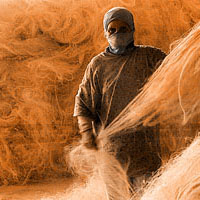
Argentina
The provision of ecosystem services and human well-being in the Pampas
of Argentina
Contact Information
- Dr. Ernesto F. Viglizzo
INTA Centro Regional La Pampa
Av. Spinetto 785 (C.C. 302), 6300 Santa Rosa
La Pampa, Argentina
evigliz@cpenet.com.ar
Project Team and Institutions
- Ernesto F. Viglizzo (INTA Argentina)
- Emilio Satorre (Buenos Aires University)
- Otto T. Solbrig (Harvard University, USA)
- Filemón Torres (CEO Consultants)
- Jorges Ingaramo (Cereals Board of Buenos Aires).
Timeframe
The assessment of condition and trends extends from 1880 to 2000, but
detailed information is provided only for the period 1960–2000. Scenarios
are projected to the year 2025.
Funding
This assessment was funded by the National Institute for Agricultural
Technology (INTA) of Argentina.
Main Findings
The assessment looks at four increasing geographical scales (farm, major
agroecosystems, the whole Pampas, and the Del Plata basin) and time periods
(from one year to four decades). Some findings in relation to the supply
of ecosystem services and their impact on human well-being in the Pampas
are the following:
- Food production: Since the beginning of colonization
(1879), the Pampas of Argentina have shown their ecological potential
for food production at a commercial scale. Crop and beef productivity
have been growing steadily at increasing rates, and this has resulted
in increased surpluses to fulfill domestic and export needs. Today,
the dynamics of Argentina’s economy strongly depend on the Pampas’ provisioning
and underlying ecosystem services. Current production is still far from
the biophysical potential of ecosystems, and there is enough room to
increase productivity through (1) the conversion of natural and cultivated
grazing lands into croplands, and (2) increased use of external inputs.
We expect that the profile of the Argentine Pampas as an international
food supplier will be confirmed in coming decades and the Pampas will
have an increasing economic impact at the regional, the national, and
the Del Plata basin scales.
- Soil erosion control and carbon sequestration capacity:
Since the end of the nineteenth century, land use conversion
for increasing food production has deteriorated the capacity of ecosystems
to control soil erosion and sequester atmospheric carbon in soil and
vegetation. Considering that these ecosystem services are coupled, they
have been affected by similar changing factors. The persistent conversion
of natural grasslands into cultivated lands, the extensive use of fire
for managing rangelands and grasslands, the introduction of ruminant
grazing cattle, and the spreading of non-conservative tillage operations
for more than 80 years, have triggered frequent soil erosion episodes
and transformed a carbon sequestering region into a carbon-emitting
one. Soil erosion has a broader scale, off-site impact (water sedimentation)
on the Del Plata basin mouth. Carbon emission from the Pampas has, on
the other hand, impact on atmospheric warming at a global scale but
which has not been fully assessed. In recent times, declines in both
these services have stopped and even been slightly reversed due to the
extensive application of no-tillage practices. These practices are driving
both a re-accumulation of soil organic carbon and a drastic reduction
in fossil fuel consumption.
- Freshwater provision: In quantitative terms, freshwater
provision is not a limiting factor for human well-being in the Pampas.
However, the increasing utilization of chemical inputs (especially pesticides
and fertilizers) due to the expansion of the cropping area is probably
affecting water quality in various areas of the region. Our regional
scale studies using models tend to demonstrate that the risk of water
contamination is increasing in areas where continuous cropping predominates.
These estimations are confirmed by non-point field measurements over
recently converted lands. Because of multiple surface and groundwater
connections, contamination at the farm scale spreads to broader scales.
- Habitat provision: All over the region, the expansion
of cultivation is causing rapid simplification of the rural landscape,
especially in continuously cropped lands. Although the systematic assessment
of biodiversity is still uncommon in the Pampas, the fragmentation of
landscapes, the utilization of conventional tillage, and the application
of pesticides have all been consistent causes of decline in habitat
provisioning. Thus we can presume that wildlife biodiversity is persistently
declining over the whole region, but particularly in the more intensively
impacted ecosystems.
- Nutrient cycling: The replacement of rangelands
and cultivated grasslands by croplands is deeply modifying the nutrient
cycling in ecosystems. Our studies have revealed an increasing weakness
of organic compartments in nitrogen (N) and phosphorus (P) cycles. The
retention of N and P in strong organic compartments has maintained a
robust functioning of nutrient cycles when rangelands and legume-based
cultivated grasslands have predominated over croplands. The expansion
of croplands during the last 20 years has caused rapid depletion of
the soil nutrient endowment and a growing use of inorganic fertilizers
(especially N) to compensate for this. Increased leakage of nutrients
and the risk of water contamination were unavoidable results. On-site
actions affecting nutrient cycles have off-site effects at wider scales.
Thus the disruption of nutrient cycles not only affects the on-site
maintenance of soil fertility, but also puts at risk the off-site provisioning
of good-quality fresh water.
References
- Bernardos , J.N., E.F. Viglizzo, V. Jouvet, F.A. Lértora, A.J. Pordomingo,
and F.D. Cid, 2001: The use of EPIC model to study the agroecological
change during 93 years of farming transformation in the Argentine pampas.
Agricultural Systems 69/3, 215–234.
- Viglizzo , E.F., A.J. Pordomingo, M.G. Castro, and F.A. Lértora,
2003: Environmental assessment of agriculture at a regional scale in
the Pampas of Argentina. Environmental Monitoring and Assessment 87,
169–195.
|

|